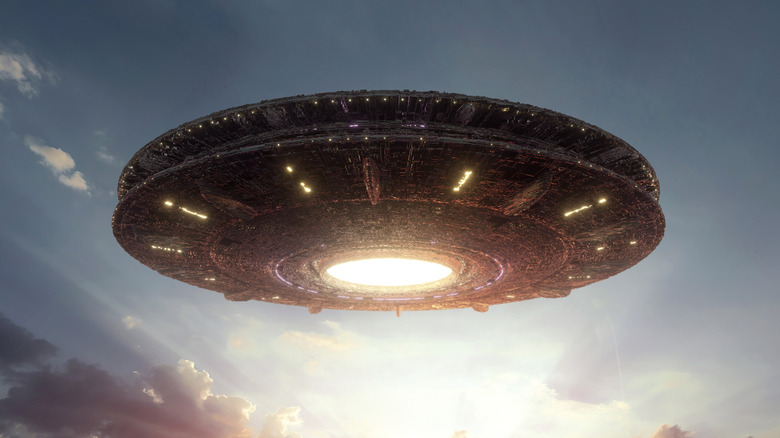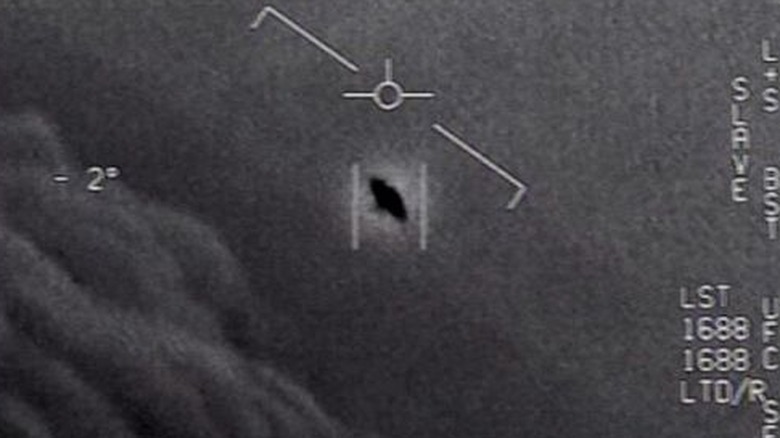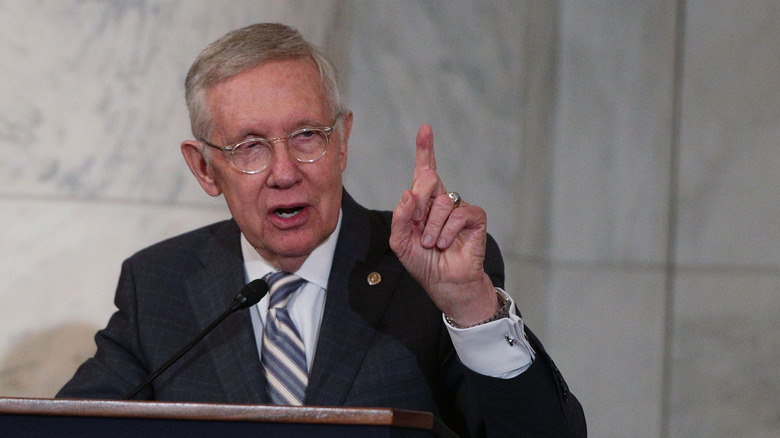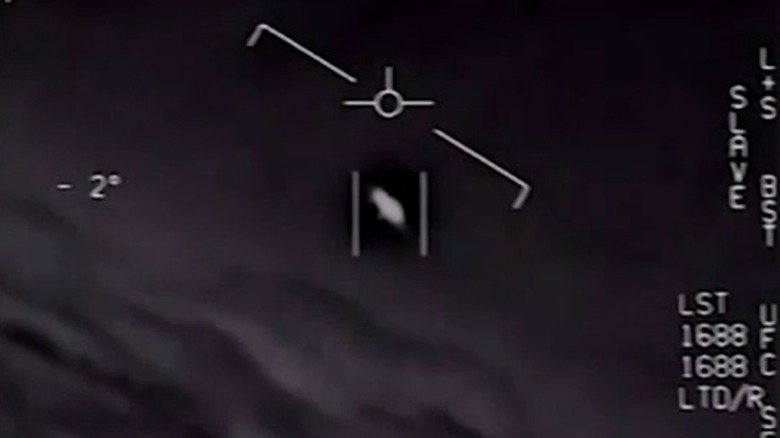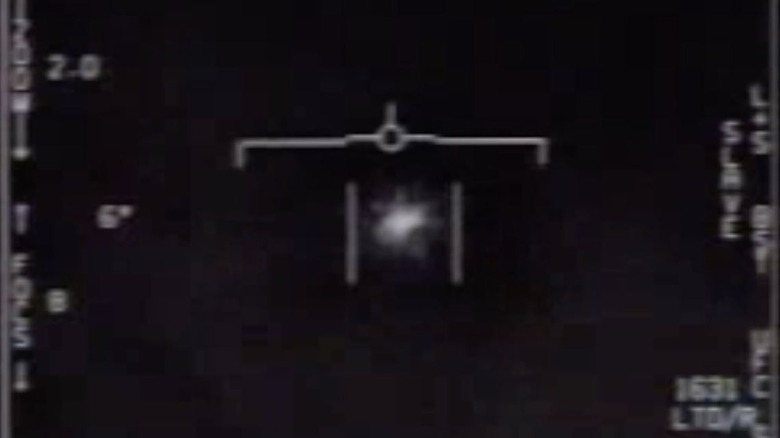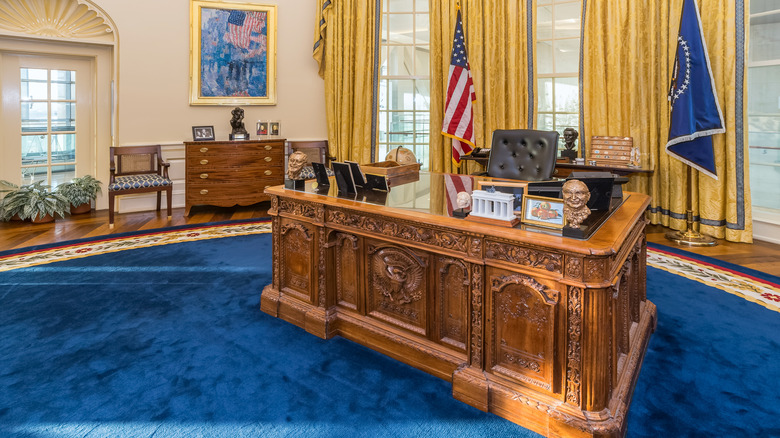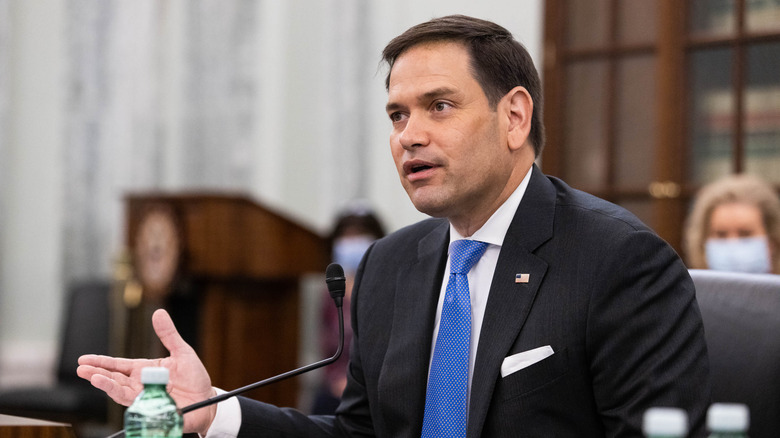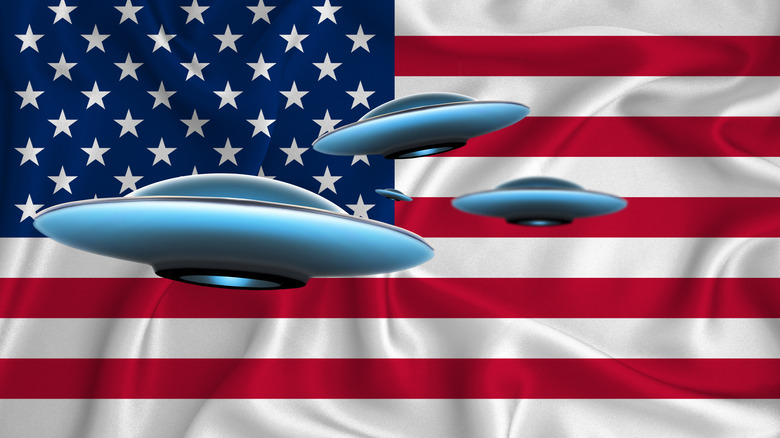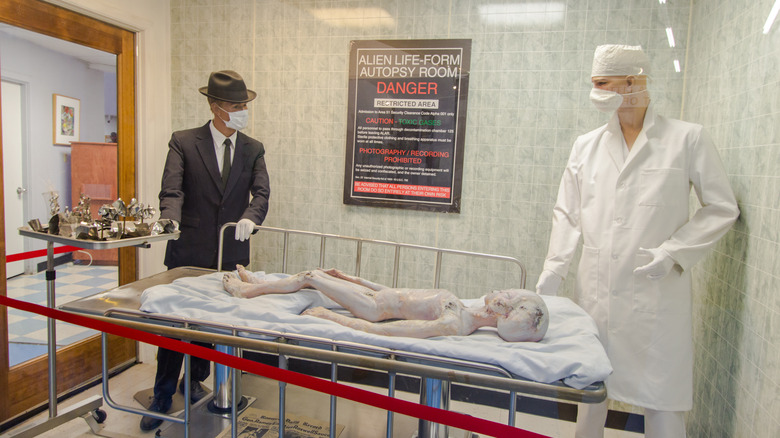What We Know About The Pentagon's UFO Report So Far
There have been many accounts over the years of alien visitations, and much of the public has long wondered if the U.S. government is hiding evidence of the existence of extraterrestrials. From the "X-Files" TV series to the "Men in Black" films and many other pop culture touchstones, the idea that we're not alone is firmly set in the public consciousness.
The United Kingdom last year opened up their database of UFO reports to the public, and this year, next month in fact, the U.S. Department of Defense will deliver to Congress a report on "unidentified aerial phenomena," what most of the world calls UFOs, according to NBC News. They were actually told to do this by Congress and the president last year, and the report is supposed to be public. Here are some details of what we can probably expect to learn about when the report is delivered to Congress in June.
The DOD released actual UFO footage last year
In 2020, according to The Guardian, the United States Department of Defense (DOD) officially released three videos "that show US navy pilots encountering what appear to be unidentified flying objects." The DOD declassified and released them officially because technically, all three already been leaked to the media and internet between 2007 and 2017. While not of the greatest quality, the footage in all three videos (per The Guardian's YouTube) clearly shows what U.S. Navy pilots saw: unfamiliar objects in the sky, moving like aircraft — but unlike any the pilots were apparently familiar with.
The audio is even clearer on this point. "What the f*** is that?" exclaims a Navy pilot as what looks like a white cylinder shoots below him. "What is that, man?" asks another pilot in the same incident, "Look at it fly!" Commander David Fravor told The New York Times in 2017 that he and his wingman were tracking an unknown object that "accelerated like nothing I've ever seen." They were 100 miles from land in the Pacific Ocean, and the object flew away faster than they could track.
Former Nevada senator Harry Reid, who has been badgering the government for decades to reveal what it knows about UFOs and aliens, said that the release of the videos by the DOD "only scratches the surface of research and materials available."
The government didn't investigate UFOs for 50 years
For most of the last fifty years, says CNN, "the US government largely ignored reports of mysterious flying objects." In an editorial for The New York Times in May 2021, former senator Harry Reid explained how he became "increasingly interested in UFOs" but was constantly "warned" by his staff and colleagues and officials to keep it to himself. He persisted, however, beleving "that an unofficial taboo regarding the frank discussion of encounters could harm our national security" and worked some senatorial shenanigans to create a "secret Pentagon program ... to take a close, scientific look at the technological implications of reported U.F.O. encounters."
The Advanced Aerospace Threat Identification Program was authorized in 2007, and Luis Elizondo, a 20-year intelligence veteran, was made director. The mission, he told "60 Minutes," "was quite simple ... to collect and analyze information involving ... UFOs." Elizondo knew nothing about UFOs but was convinced by the work of his team that they were real enough to warrant attention. "Ultimately when you have exhausted all those what ifs and you're still left with the fact that this is in our airspace and it's real," he said, "that's when it becomes problematic." He replied, when asked by the CBS interviewer if UFOs are real, that he isn't saying it: "The United States government is telling you that."
Funding for the program was canceled in 2012, and despite repeated attempts, Elizondo was never able to get anyone at the Pentagon to act on his findings.
UFO footage was leaked by a high-ranking Pentagon official and the singer of Blink-182
After the program was shuttered, Elizondo kept working at the Pentagon and continued trying to get someone to pay attention to what he believed could be a national security concern. "This topic is no different than any other national security issue, and we must remain diligent, deliberate and discerning," he explained to NBC News. Elizondo did manage to get the three videos declassified but was unable to get them in front of the right eyeballs. Finally, after five years of frustration, he quit working at the Pentagon in 2017.
Elizondo's friend, Christopher Mellon, former deputy assistant secretary of defense for intelligence for Presidents Clinton and George W. Bush, had been helping him, with similarly fruitless results. After failing to get the secretary of defense or anyone else to take the matter seriously, Mellon decided, he told "60 Minutes," "to go to the public, get the public interested to get Congress interested, [and] then circle back to the Defense Department." He leaked the three declassified Navy videos to The New York Times in 2017.
Mellon and Elizondo also gave one of the videos to To the Stars Academy of Arts and Sciences, a tech company co-founded by Tom DeLonge, lead vocalist of '90s band Blink-182. The company "collects documents and physical materials from public and private sources related to the UAP phenomena to study it" and has Pentagon officials, intelligence agents, and aerospace engineers on the board. TSAA then leaked that video, too.
Military pilots see UFOs all the time
With the videos not only leaked to the press but to the highly respected New York Times, military eyewitnesses began to come forward and tell their stories, too. Lieutenant Ryan Graves was a U.S. Navy pilot who, as he told "60 Minutes," started seeing UFOs in 2014. It's actually his squadron that appears in one of the leaked videos, training off the Atlantic coast, near Virginia Beach, where they would see these unidentified objects, he said, "Every day. Every day for at least a couple years." But reports were rarely filed.
Lieutenant Alex Dietrich was among the pilots who encountered a UFO in 2004, reported by multiple pilots and ships in the USS Nimitz carrier group. She admitted, however, that "if I saw this solo, I don't know that I would have come back and said anything." This sentiment was echoed by her wing commander, David Fravor, who explained, "I've had some people tell me, you know, 'When you say that, you can sound crazy.'"
"There have been sightings all over the world," said former national intelligence director John Ratcliffe to Fox News in March 2021. He also stated that "there are a lot more sightings" than the general public knows about and said that many of these encounters are well-documented, reported by credible and qualified observers (like military pilots), and confirmed by "multiple sensors," from satellites to Navy vessels.
The U.S. Navy updated their UFO procedures in 2019
None of this is to say that the United States' defense apparatus did nothing about all these reports. In 2019, a mere two years after the DOD confirmed the existence of UFOs and that Navy and Air Force pilots had been seeing them regularly for a long time, just two years after verified footage of three separate incidents involving U.S. Navy pilots came to the public eye, the Navy started writing an official procedure for reporting UFO encounters.
"For safety and security concerns, the Navy and the [U.S. Air Force] takes these reports very seriously," said a U.S. Navy statement to Politico in response to their questions about the updated rules. "A new message to the fleet that will detail the steps for reporting is in draft."
While 15 years after the Nimitz incident may seem a bit tardy to the party, anything that aims to incorporate more data and ensure accuracy in reporting represents a welcome "sea change" in attitude, former Pentagon official Chris Mellon told Politico. The next year, the DOD formed a new UFO task force (the Unidentified Aerial Phenomena Task Force, or UAPTF) to investigate whether they "potentially pose a threat to U.S. national security." However, this does not technically mean the government is investigating what UFOs are, just that they're seeing if they are dangerous.
There won't be any UFOs in the report — they're called something else
"Throughout recorded history," says The Classical Journal, "reports of what we today might call unidentified flying objects have been made and preserved." As far back as ancient Rome, and all over the world, people have seen unexplained things in the sky. But the phenomenon really kicked off in the 20th century, specifically after World War II. We say "unidentified flying object" and its popular abbreviation "UFO" today because the U.S. Air Force called it that in a 1952 report and, according to the Air Force Declassification Office, "initially defined UFOs as those objects that remain unidentified after scrutiny by expert investigators."
The report that the U.S. Department of Defense will present to Congress will not actually talk about UFOs at all, however — it'll be talking about UAPs, unidentified aerial phenomena. The new term, reports Scientific American, was deliberately coined by "a cohort of military, aviation and political observers" in order to "change the label to a less pejorative phrasing" and has been the vogue term among the UFO UAP community for at least a decade. The 2020 task force was named after and exclusively uses the term as well. "The Department of Defense," says the DOD press release, "established the UAPTF to improve its understanding of, and gain insight into, the nature and origins of UAPs." You can also expect that the final report next month will, no matter what exciting revelations it might contain, will read as dryly as that release.
At least two presidents knew UFOs are real
U.S. intelligence agencies may be delivering a groundbreaking report to Congress, but at least two former presidents have known of the existence of UAPs for quite some time. Donald Trump was actually the first sitting president, according to Newsweek, to publicly admit to having been briefed on the issue. "I did have one very brief meeting on it," Trump said to ABC News in 2019, "Do I believe it? Not particularly." Mr. Trump's predecessor was obviously likewise informed, although he never said so while he was in office and technically still sort of hasn't.
The same week that "60 Minutes" UFO episode aired in May 2021, Barack Obama revealed some of what he knew on "The Late Late Show with James Corden." As CNN tells it, Mr. Obama explained that one of the first things he did as president was to ask the people he was now in charge of, "Alright, is there the lab somewhere where we're keeping the alien specimens and space ship?" It was a question that, according to Newsweek, former president Bill Clinton told a similar joke about to Jimmy Kimmel in 2014. Obama however, after assuring everyone that he was joking, followed up with a somber clarification: "I'm actually being serious here, is that there are, there's footage and records of objects in the skies, that we don't know exactly what they are."
Marco Rubio forced the government to write the UFO report
The Pentagon's UAP report stems from the Intelligence Authorization Act for Fiscal Year 2021, which, among other things, tasks the intelligence community with the "Identification of potential aerospace or other threats posed by the unidentified aerial phenomena to national security." The act was written in June 2020, but the report was only ordered in December, when then-President Donald Trump signed the last COVID-19 relief bill of the year, reports the Tampa Bay Times. It turns out that the Senate Intelligence Committee weaved some legislative hocus-pocus last year, and the Office of Naval Intelligence, the Unidentified Aerial Phenomena Task Force, and the FBI were instructed, as part of a pandemic relief bill, to deliver a report on UAPs to Congress.
Florida Senator Marco Rubio chaired the committee at the time and takes credit for mandating the report. "Men and women we have entrusted with the defense of our country are reporting encounters with unidentified aircraft with superior capabilities," Rubio explained to the Tampa Bay Times. "We cannot allow the stigma of UFO's to keep us from seriously investigating this." The Times reports that the senator later told "60 Minutes" that "the public deserves to know as much as possible about it." The Intelligence Authorization Act does indeed stipulate that the report is to be given to Congress "in unclassified form," though it is allowed to also "include a classified annex." We'll see how many times the word "REDACTED" appears in the final product.
The Pentagon's report won't actually explain what UFOs are
When the Senate Intelligence Committee directed the Department of Defense to produce the report, members like Senator Rubio were apparently more concerned with a systemic analysis of the gathering of intelligence pertaining to UAPs and less with what UAPs actually are. The first paragraph in the relevant section of the Intelligence Authorization Act for Fiscal Year 2021 ("Advanced Aerial Threats" under the "Committee Comments" portion) explains that while "The Committee supports the efforts of the Unidentified Aerial Phenomenon Task Force," they also are "concerned that there is no unified, comprehensive process within the Federal Government for collecting and analyzing intelligence on unidentified aerial phenomena."
It is repeatedly emphasized that the report should not only include, as CNN explains, details of what the DOD knows but also specify "an interagency process for ensuring timely data collection and centralized analysis of all unidentified aerial phenomena reporting for the Federal Government" as well as explain who exactly is in charge of those details and the process which is supposed to provide them. The eight points in the UAP section of the Intelligence Act describing the report requirements end with a demand for "Recommendations regarding increased collection of data, enhanced research and development, and additional funding and other resources." In other words, Congress wants the government to be able to explain what we know about UAPs, how we know what we know, what threat they pose, and who gets fired for screwing any of that up.
The Pentagon's report will probably not be about aliens
The main focus of the report should be on what danger, if any, UAPs present. As Senator Rubio explained to "60 Minutes": "I want us to take it seriously and have a process to take it seriously." The committee comments he authored clearly state that the report should explain "any links [UAPs] have to adversarial foreign governments, and the threat they pose to U.S. military assets and installations." Two of the eight points in the report requirements are explicitly about discovering if UAPs "may be attributed to one or more foreign adversaries" or "indicate a potential adversary may have achieved breakthrough aerospace capabilities" that put national security at risk.
There is no mention of aliens or anything otherworldly in the Intelligence Authorization Act, and the Department of Defense has repeatedly stressed that their main concern is, as the Pentagon press secretary said in response to a question on the matter in May 2021, "the safety and security of our personnel and of our operations that they remain paramount." As it is supposed to detail all the accounts from all the personnel who've reported UAP encounters — like that of Commander David Fravor, who told ABC News that he believes what he confronted "was not from this world," or the testimony of former Advanced Aerospace Threat Identification Program director Luis Elizondo, who told CNN that "we may not be alone" — the DOD report will almost certainly mention aliens, but we shouldn't expect much more than that.
